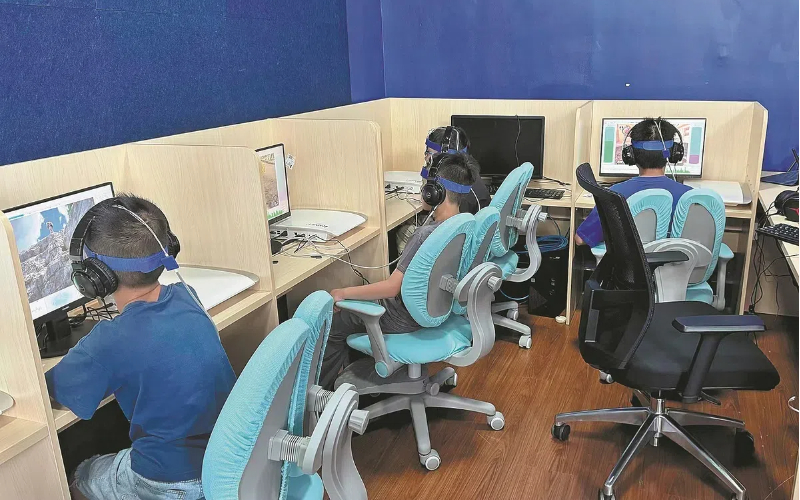Zhejiang's brain training program helps treat ADHD

Children receive EEG biofeedback treatment for ADHD at the rehabilitation department of the Children's Hospital of the Zhejiang University School of Medicine in Hangzhou, Zhejiang province. [Photo provided to China Daily]
During a visit to the rehabilitation department of the Children's Hospital of the Zhejiang University School of Medicine earlier this month, a third grader identified as Pengpeng sat in front of a screen and participated in a race car "video game" — without using his hands.
He and his peers controlled the cars on the screen with their minds through electrodes attached to their bodies, with their brainwaves decoded via Bluetooth.
The video game method is part of an electroencephalograph biofeedback therapeutic treatment designed for children with attention deficit hyperactivity disorder. It's one of the novel treatment approaches offered at the rehabilitation department's Brain Regulation Attention Training Camp, an initiative by the medical school to translate successful research into clinical practice.
The children's hospital is at the forefront of this effort among Chinese medical centers. Unlike traditional medication, EEG biofeedback requires active participation from the patient.
It uses high-tech instruments to collect the patient's real-time brainwave data, allowing the brain to control images on a screen. The technology helps identify ways to regulate the patient's bodily processes and has been found to be an effective treatment for ADHD.
Pengpeng struggles with common ADHD symptoms: he can't sit still in class, his mind often wanders during lessons, he procrastinates on homework and his grades suffer as a result. Concerned about their child's condition, his parents brought him to see Li Haifeng, chief physician and director of the children's hospital's rehabilitation department, at the start of summer vacation.
After comprehensive assessments, including psychological scales, EEG and blood tests, Pengpeng was diagnosed with ADHD.
After learning about the training camp, Pengpeng's parents canceled a planned overseas trip to enroll him in the program, hoping to take advantage of the summer break for timely intervention.
Children age 6 to 14 recently attended the camp, which is held at the hospital regularly.
Li developed a personalized, multidimensional intervention plan tailored to Pengpeng's specific needs. During Pengpeng's 10-day visit, he participated in working memory therapy, cognitive psychological therapy and sand play therapy to enhance his focus and self-control.
In addition, he received brain regulation treatment using repetitive transcranial magnetic stimulation, which involves sending repeated low-intensity magnetic pulses to specific brain areas to regulate neural activity, and EEG biofeedback.
EEG biofeedback monitors brain performance and converts brainwave signals into visual or auditory feedback to aid in self-regulation, thereby improving psychological and physiological states. During treatment, patients learn to relax or concentrate by observing feedback, gradually mastering control of their brainwave activity to achieve therapeutic goals. The technique helped Pengpeng self-regulate his brainwaves, improving his emotional state, attention and memory.
"Pengpeng's favorite activity was the daily 30-minute EEG biofeedback session," his mother said. "He was completely immersed in the interactive games on the screen. It's amazing to see that watching videos can treat ADHD."
After 10 days of treatment, cognitive tests conducted on Pengpeng showed significant improvement. He could maintain attention for longer periods, listen more patiently and respond more quickly. He also made new friends with his fellow campers, attending classes and commuting home with them each day.
Li, the physician, said: "We can confirm that the short-term efficacy of brain regulation technology is comparable to medication, but it is much safer. Medication often has side effects that affect sleep, growth and heart function, causing many parents to discontinue it."
In addition to being drug-free and noninvasive, the technology can help treat various symptoms, including inattention, impulsivity, hyperactivity, tics, emotional disorders and sleep disturbances.


